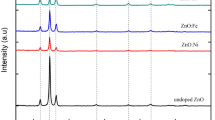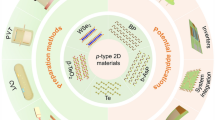Abstract
The effect of pH on the performance of undoped silicon carbide nanowire field-effect transistors (SiCNW-FETs) was systematically studied using various solutions with pH ranging from pH 2 to pH 13 and important transport parameters such as transconductance, mobility, and resistivity were reported. Interestingly, at 2 V, alkaline solutions with high pH value (pH 13) revealed a higher transconductance of 7.13 nS and lower resistivity of 40 Ω cm as compared to acidic solutions with 0.01 nS and 2.1x104 Ω cm at pH 2, respectively. A model describing the pH-dependent conductance of the SiCNW-FETs was proposed. Moreover, a comprehensive comparison of the pH effects on the transport properties of the undoped SiCNW-FETs and nitrogen-doped SiCNW-FET was presented and the measurements clearly revealed opposite trends for a wide range of pH solutions. In short, our SiCNW-FETs with high sensitivity, high stability, and minuscule sample volume can provide solutions for the development of harsh environment compatible nanosensors for chemical, biochemical, and environmental sensing applications.



source voltage (Vds) curves of device “A” (two SiCNWs) with constant gate voltage (Vg) of 0 V after applying different pH values (pH 2, pH 3, pH 5, pH 7, pH 9, pH 11, and pH 13); (b) Ids − Vg curves of device “A” while keeping Vds constant (0.01 V) at various pH values ranging from pH 2 to pH 13.



Similar content being viewed by others
References
N.P. Dasgupta, J. Sun, C. Liu, S. Brittman, S.C. Andrews, J. Lim, H. Gao, R. Yan, and P. Yang, 25th Anniversary article: semiconductor nanowires-synthesis, characterization, and applications. Adv. Mater. 26, 2137 (2014).
C.C. Yee, Md. K. Marshad, M. Nuzaihan, M.F.M. Fathil, and U. Hashim, Fabrication and characterization of undoped polysilicon nanowire for pH sensor. 2014 IEEE Int. Conf. Semicond. Electron. 396, 1520 (2014).
J. Feng, X. Li, G. Zhu, and Q.J. Wang, Emerging high-performance SnS/CdS nanoflowers heterojunction for ultrafast photonics. ACS Appl. Mater. Interfaces. 12, 43098 (2020).
J. Hsu, B. Huang, C. Huang, and H. Chen, Silicon nanowires as pH sensor. Jpn. J. Appl. Phys. 44, 2626 (2005).
M. Ham, J. Choi, W. Hwang, C. Park, W. Lee, and J. Myoung, Contact characteristics in GaN nanowire devices. Nanotechnology 17, 2203 (2006).
H. Zeng, G. Zhang, K. Nagashima, T. Takahashi, T. Hosomi, and T. Yanagida, Metal-oxide nanowire molecular sensors and their promises. Chemosensors. 9, 1 (2021).
T.H. Kim, S.Y. Lee, N.K. Cho, H.K. Seong, H.J. Choi, S.W. Jung, and S.K. Lee, Dielectrophoretic alignment of gallium nitride nanowires (GaN NWs) for use in device applications. Nanotechnology 17, 3394 (2006).
F. Roccaforte, F.L. Via, V. Raineri, P. Musumeci, L. Calcagno, and G. Condorelli, Highly reproducible ideal SiC Schottky rectifiers: effects of surface preparation and thermal annealing on the Ni/6H-SiC Barrier height. Appl. Phys. A Mater. Sci. Process. 77, 827 (2003).
K. Teker, Density and morphology adjustments of gallium nitride nanowires. Appl. Surf. Sci. 283, 1065 (2013).
P. Tanner, A. Iacopi, H. Phan, S. Dimitrijev, L. Hold, K. Chaik, G. Walker, D.V. Dao, and N. Nguyen, Excellent rectifying properties of the N-3C-SiC/p-Si Heterojunction subjected to high Temperature annealing for electronics, MEMS, and led applications. Sci. Rep. 7, 10025 (2017).
K. Rogdakis, M. Bescond, E. Bano, and K. Zekentes, Theoretical comparison of 3C-SiC and Si nanowire FETs in ballistic regime. Mater. Sci. Forum 579, 600 (2008).
A. Meng, M. Zhang, J. Zhang, and Z. Li, Synthesis and field emission properties of silicon carbide nanobelts with a median ridge. CrystEngComm 14, 6755 (2012).
J. Ahn, J. Kim, M. Seol, D.J. Baek, Z. Guo, C. Kim, S. Choi, and Y. Choi, A pH sensor with a double-gate silicon nanowire field-effect transistor. Appl. Phys. Lett. 102, 083701 (2013).
J. Jang, S. Choi, J. Kim, T.J. Park, B. Park, D.M. Kim, S.J. Choi, S.M. Lee, D.H. Kim, and H. Mo, Effect of liquid gate bias rising time in pH sensors based on Si nanowire ion sensitive field effect transistors. Solid-State Electron. 140, 109 (2018).
S.C. Stephen, Md. K. Marshad, Md. N. Mnor, M.F.M. Fathil, A.R. Ruslinda, and U. Hashim, Fabrication and characterization of doped polysilicon nanowire for pH sensor. Appl. Mech. Mater. 561, 754 (2015).
S. Sinha, R. Mukhiya, R. Sharma, P.K. Khanna, and V.K. Khanna, Fabrication, characterization and electrochemical simulation of AlN-gate ISFET pH sensor. J. Mater. Sci. Mater. Electron. 30, 7163 (2019).
M. Awais, H. Mousa, and K. Teker, Effect of pH on transport characteristics of silicon Carbide Nanowire field-effect transistor (SiCNW-FET). J. Mater. Sci. Mater. Electron. 32, 3431 (2021).
S. Paiman, T.H. Ling, M. Husham, and S. Sagadevan, Significant effect on annealing temperature and enhancement on structural, optical and electrical properties of zinc oxide nanowires. Results Phys. 17, 103185 (2020).
A. Uzun, and K. Teker, Silicon carbide nanowire field effect transistors with high on/off current ratio. Microelectron. Eng. 205, 59 (2019).
D.E. Yates, S. Levine, and T.W. Healy, Site-binding model of the electrical double layer at the oxide/water interface. J. Chem. Soc. Faraday Trans. 70, 1807 (1974).
S.F.A. Rahman, N.A. Yusof, U. Hashim, and Md. N. Mnor, Design and Fabrication of Silicon Nanowire based Sensor. Int. J. Electrochem. Sci. 8, 10946 (2013).
S. Tang, J. Yan, J. Zhang, S. Wei, Q. Zhang, J. Li, M. Fang, S. Zhang, E. Xiong, Y. Wang, J. Yang, Z. Zhang, Q. Wei, H. Yin, W. Wang, and H. Tu, Fabrication of low cost and low temperature poly-silicon nanowire sensor arrays for monolithic three-dimensional integrated circuits applications. Nanomaterials 10, 2488 (2020).
Acknowledgements
KT gratefully thanks the Istanbul Development Agency (ISTKA) for providing funding for this research (Grant No: TR10/16/YNY/0102).
Author information
Authors and Affiliations
Corresponding author
Ethics declarations
Conflict of interest
The authors declare that they have no known competing financial interests or personal relationships that could have appeared to influence the work reported in this paper.
Additional information
Publisher's Note
Springer Nature remains neutral with regard to jurisdictional claims in published maps and institutional affiliations.
Rights and permissions
About this article
Cite this article
Mousa, H., Awais, M. & Teker, K. Investigation of pH Effect on the Performance of Undoped Silicon Carbide Nanowire Field-Effect Transistors for the Development of Chemical Sensors and Biosensors. J. Electron. Mater. 51, 2062–2069 (2022). https://doi.org/10.1007/s11664-022-09468-z
Received:
Accepted:
Published:
Issue Date:
DOI: https://doi.org/10.1007/s11664-022-09468-z




